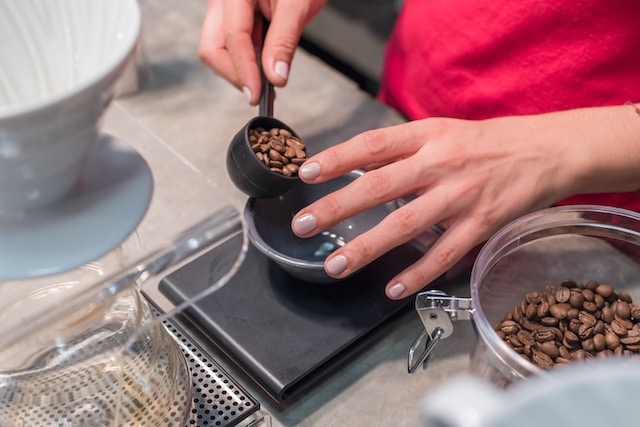We make our coffee by brewing coffee grounds with hot water. In many cases, we simply scoop out the grounds or grind the coffee ourselves. However, have you ever considered the number of coffee beans to make coffee? How many coffee beans per cup are needed?
You use about 55 coffee beans to make a standard 6-ounce (180ml) cup of coffee. However, the actual coffee beans used may change based on several factors. These are roasting, coffee variants, grind level, or brewing style.
In this article, we explore how many coffee beans per cup are needed to make a cup of coffee. We also look into the factors that affect how many beans you need. Finally, we examine whether measuring coffee by beans is a good idea.
How Many Coffee Beans Per Cup?
Before arriving at the final number of coffee beans to make a cup of coffee, let’s look at the recommended coffee-to-water ratio.
According to the Specialty Coffee Association (SCAA), it takes about 8.25 grams of coffee to brew up a 6 fluid ounce (180ml) coffee.
Now that we know the ratio let’s convert that into the number of coffee beans. A coffee bean usually weighs around .12 to .17 grams. Many factors may contribute to the difference in weight, such as roasting, size, and all.
Let’s take the middle range and assume a coffee bean is around .15 grams. To have 8.25 grams of coffee, you will need around 55 coffee beans.
This means to make a 6-ounce cup of coffee per the SCAA’s Golden Cup standard, you need 55 coffee beans.
However, do understand that the 55 coffee beans may not always apply. You may encounter situations when you may need more or less. This is because many factors could determine how many beans you need to make your cup of coffee.
What Affects The Number Of Coffee Beans Per Cup Of Coffee?
Roasting
Coffee beans are subjected to some roasting before being sold. Roasting removes moisture inside the bean, causing it to lose weight.
You may assume that the darker the roast, the more moisture is lost. This may mean you need more dark roasted beans to make your coffee.
Coffee Variants / Cultivar
There are four major coffee types, or cultivars, in the world. These are Arabica, Robusta, Liberica and Excelsa. These bean cultivars can vary in size and weight.
For example, the average size of a Liberica coffee bean is bigger than regular Arabica or Robusta. This means you would need less of it if you are brewing your coffee using Liberica beans.
On top of that, you also have odd coffee variants, such as Peaberry. Peaberry coffee beans could be considered a 2-in-1 since the beans fail to split when growing. Regular coffee berries produce two beans instead.
Peaberry would be larger and heavier, meaning you will need less of them to make your cup of coffee.
Grind Level
The common rule here is that the finer your grind size, the more coffee beans you will require to make a cup of coffee.
The reason is simple – when you grind the beans down into finer sizes, you may need more to pack them into your brewer.
The concept here is similar to filling a bottle with rocks or sand. You usually need more sand since they do not leave much space in between.
You translate that concept to trying to fill up an espresso portafilter. You will need more coffee grinds to do that, which also means more coffee beans.
Brewing Style
Some brewing styles may require you to use more coffee beans than others. These brewing styles usually use finer grinds or aim to produce really strong coffee. Think about espresso or Turkish coffee.
You will need more coffee grounds to fill up the portafilter when brewing espresso. You can assume the same with making Turkish coffee. Chances are you will need to be generous on the grounds to fill up the Cezve pot too. This means you will need more beans.
However, more casual brewing styles may not need too many beans. This is because the coffee beans are grounded coarser. These styles may include French press, Drip machines, or percolators.
Is Measuring Coffee By Beans A Good Idea?
Generally, you want to avoid measuring coffee by beans. This is because too many factors could determine the right amount of beans to make your coffee.
It can be very hard to weigh up to exactly 8.25 grams of coffee beans too, since every single bean has a different weight.
Plus, even if you are geeky enough to weigh every single bean, you may not be able to reach 8.25 grams exactly. This is because the beans are of different weights, so you must also weigh and change coffee beans.
Instead, measure beans by weight. Grind the beans down with a grinder, then weigh the coffee ground. You can also use a coffee scoop to help you measure the right amount.
This would be a better, easier, and more straightforward way to get the right amount of coffee to brew your cup of joe.

Wrapping Up
This article explored how many coffee beans you need to make a cup of coffee. We also looked at the factors that may determine the bean count and why measuring coffee by beans is a bad idea.
Have you checked out 26 types of coffee you can brew with your coffee beans? Check the article out and see how many you have tried yourself.
Frequently Asked Questions About How Many Coffee Beans Per Cup
It may take around 55 beans to make a cup of coffee. The actual number may change depending on coffee bean types, grind level, or brewing style.
Yes. Certain brewing methods such as espresso, or Turkish coffee may require you to use more coffee. This is because the beans are ground fine, which means you need more to pack the portafilter, and the Cezve.
The best way to measure coffee is to grind it down, and then measure by weight. This is because you can achieve a more accurate portion of coffee, compared to counting beans.

I’m Joel, an espresso-loving coffee nerd. I got into coffee because I spent a lot of time in Milan as a kid and started liking coffee waaaay too young. I’m all about making sure espresso is treated with the same care as any other coffee – it’s not just a quick drink!


Leave a Reply